The Spastic Image
Established
That Canon system is one heck of a nice shooting, nicely styled, very functional system. I just got my maiden roll scans back from the lab on my Canon L1, and Canon 50mm/f2.8. Sharp and plenty of glow even wide open. Every shot of Fujicolor 400 was bang on and Leicalike. Enjoy that Canon. Agree the dual viewfinder would get in the way!I think this is interesting because of the overall complexity/ridiculousness of this finder, a Canon twin turret zoom finder. I do not know when this finder was made, but I am guessing late 1950s. I have used this finder a few times, and while functional, it is a lot of stuff to be hanging off your camera, and very likely to be snagged on camera straps, sweaters, etc. That said, the view through this finder is quite bright and framing is accurate. The smaller turret has click stops for 50, 45, 40 and 35mm. If you attach the separate lens for 21 to 28mm to the smaller turret, these same click stops provide framing for 28, 25 and 21mm. The second turret provides views for 85, 90, 100, 105, 110, 125 and 135. The shoe of the finder has a lever for parallax adjustment from 3.5 feet to infinity. Lastly, the finder and 21-28 attachment have fitted leather cases lined in thick blue velvet. At 6.5 cm long and about 5cm tall it is a chunky finder, and weighs 140g/4.9 ounces
I missed the focus on the last pic, but losing enough sunlight to re-take the photo.
David Murphy
Mentor
Wow, beautiful 135/3.5 Honor lens, and I'm sure uncommon. This would be great on my Honor body!
furcafe
Mentor
I might have post this here before somewhere, but this a rare Zuiho Japanese-made Honor Leica III copy that I just lucked into by chance one day on eBay in an out place listing with no associated fan-fare. It is in close to new condition, except for some deterioration on the film counter dial numbering. There are a few of these traded in Japan, but they are rare here. This one appears never to have been used! Someone obviously bought it decades ago, stored it away, and now it sees the light of day!
Nice. Reminds me that I need to take mine out for some shooting.
milescl
Well-known
I recently purchased a group of Canon rangefinder lenses and only after they arrived did I realize the 35mm f1.8 (serial # 10,005) represents the 5th example made in the first production run.
This is now the earliest lens (in terms of its production range) I own.
Excited to take it out tonight for the first time at a friends gathering — shooting tmax 400 on the M-A.
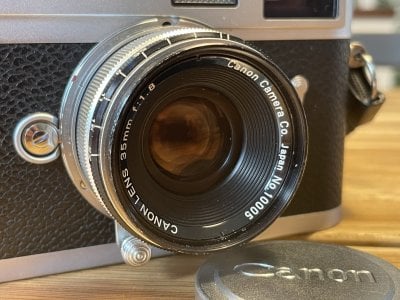
This is now the earliest lens (in terms of its production range) I own.
Excited to take it out tonight for the first time at a friends gathering — shooting tmax 400 on the M-A.

dexdog
Mentor
This is an unusual lens, a CZJ f2 Sonnar in Contax mount marked 50mm, instead of the usual 5cm. Part of a batch of 800 lenses completed October 1950. Three following batches of 600 lenses completed in January and March 1951 marked the end of production of CZJ f2 Sonnars if I am interpreting Thiele's book correctly.


Räuber
Established
This is an unusual lens, a CZJ f2 Sonnar in Contax mount marked 50mm, instead of the usual 5cm. Part of a batch of 800 lenses completed October 1950. Three following batches of 600 lenses completed in January and March 1951 marked the end of production of CZJ f2 Sonnars if I am interpreting Thiele's book correctly.

Good eye! You have spotted this right. CZJ switched the naming scheme at this batch from 1950. They started to use the modern 50mm focal length description we are used Today. The funny thing is that they had to stop the Contax Sonnar production after the next batch. Probably the Soviet administration wanted to end the competition between the CZJ Sonnar and Jupiter. They might have seen the Jena Sonnar production as a fill in until their own Jupiter production is on full speed.
Which version of the F2 Sonnar do you get? The one with black or with silver mount? I guess it is the all chrome (silver mount) version.
It is not the lowest 50mm F2 Sonnar I have seen. Currently that title goes to this one:

Zeiss Ikon CONTAX Zeiss Sonnar 50mm f2 B98134 jp105 | eBay
We don’t declare lower values. Optics with glass fungus.
www.ebay.de
Last edited:
dexdog
Mentor
My lens is in silver mount. Cost $31 on an eBay auction last week. Glass is in excellent condtion, too.Good eye! You have spotted this right. CZJ switched the naming scheme at this batch from 1950. They started to use the modern 50mm focal length description we are used Today. The funny thing is that they had to stop the Contax Sonnar production after the next batch. Probably the Soviet administration wanted to end the competition between the CZJ Sonnar and Jupiter. They might have seen the Jena Sonnar production as a fill in until their own Jupiter production is on full speed.
Which version of the F2 Sonnar do you get? The one with black or with silver mount? I guess it is the all chrome (silver mount) version.
It is not the lowest 50mm F2 Sonnar I have seen. Currently that title goes to this one:

Zeiss Ikon CONTAX Zeiss Sonnar 50mm f2 B98134 jp105 | eBay
We don’t declare lower values. Optics with glass fungus.www.ebay.de
Last edited:
Coldkennels
Barnack-toting Brit.
That's an absolute steal!My lens is in silver mount. Cost $31 on an eBay auction last week.
Räuber
Established
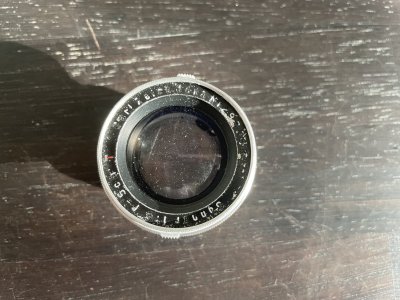
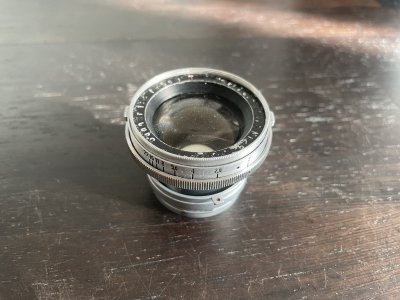
This beaten up collapsible Carl Zeiss Jena Sonnar 5cm f/2 got in my hands lately. It is hard to see because the paint of the lens inscription on the name ring is coming off but it is one of the latest collapsible Sonnars that survived. It has the serial number 2.935.687. It is the first lens from a 1946 batch I have ever seen. This one is coated with the typical Zeiss T coating. It might be assembled in SU though as a lot of those late post-war Sonnar lenses seem to have ended up in the Soviet union and were assembled into ZK or Sonnar lenses there.
dexdog
Mentor
Good find! I have never seen a 293 series sonnar, although one of the collapsible 5cm/2 sonnars I have has a 293 serial number on rear lens group
raid
Dad Photographer
I enjoy seeing here such special finds.
raid
Dad Photographer
I mentioned before that I have Zeiss 5cm/2 that at some time "someone" crafted out of a lens shell for an Elmar and glass by Zeiss. It is very clean cosmetically and also the glass is clean. It seems to give a warm hue to images. Its glass suggests that it is one out of 200 lenses that were traded between Germany and Sweden in return for iron ore. It is a lens with a story to tell. Was it ever used in Sweden? Was the lens crafting done by Leitz or by some individual lensmaker? It is a lens that is meant for a "lens detective". In Statistics and Data Science I refer to my students as "data detectives".
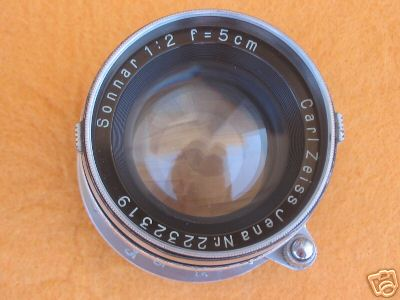

Last edited:
Vince Lupo
Nobody's Mentor
I finally figured out the problem with this thread - no Hasselblad stuff! Don't worry, I can fix that 
First up - a Ross tripod head. The Ross name dates to about 1940, about 8 years before Victor Hasselblad came out with the 1600f. I contacted Richard Nordin (author of the amazing Hasselblad Compendium) about this head and this was his response:
"The Ross ball head is indeed a rare find in the US - almost all were sold in Sweden. The Ross ball head was made and sold from about 1945 to 1950 along with a number of other photo accessories through Victor’s retail shops and mail order. These are described and illustrated in the Hasselblad Compendium book (p16). The ball head was also manufactured through the 1950s but with the Hasselblad “winged V” logo engraved on it (p 74 in the Compendium).
The only explanation I had for why the brand name Ross was chosen for the products is that Victor wanted a simple British / American brand name as his goal was to sell to these markets in the long term. He argued against naming his camera using his own name - he felt it would be too strange and exotic to American buyers - but he was finally convinced."
During the 1950's they did offer a Hasselblad-branded tripod head that was almost identical to this one, but with a 1/4-20 thread. I paid very little money for this head - I think it was about $50 in total including shipping. Interestingly it came from a Swedish eBay photographic seller who was unaware of the Ross/Hasselblad connection.

Ross Sweden Tripod Head by Vince Lupo, on Flickr
Next is my 60mm f/4 Distagon lens. Made for only one year (from 1962 to 1963) and about 1900 examples produced. I have no idea why they only made them for the one year. Some have speculated that it was some kind of limited edition, but I have no idea what they may have been commemorating.

60mm Distagon by Vince Lupo, on Flickr
Finally, this little beauty (well actually really big and heavy!) and my favourite Hasselblad lens:

12.5cm f:2 Schneider-Göttingen2 by Vince Lupo, on Flickr
This lens was originally affixed to a Fritz Völk hk12,5 aerial reconnaissance camera during WWII. I suppose one could consider it a German-made equivalent to an Aero Ektar? In any case, I have no idea how it happened to end up mounted in a focusing barrel/helicoid with a 1600f/1000f lens mount -- perhaps Schneider may have done this after the War with surplus lenses? I've seen these kinds of focusing barrels/helicoids on other Schneider lenses, so I don't think it was a homemade-type of creation.
First up - a Ross tripod head. The Ross name dates to about 1940, about 8 years before Victor Hasselblad came out with the 1600f. I contacted Richard Nordin (author of the amazing Hasselblad Compendium) about this head and this was his response:
"The Ross ball head is indeed a rare find in the US - almost all were sold in Sweden. The Ross ball head was made and sold from about 1945 to 1950 along with a number of other photo accessories through Victor’s retail shops and mail order. These are described and illustrated in the Hasselblad Compendium book (p16). The ball head was also manufactured through the 1950s but with the Hasselblad “winged V” logo engraved on it (p 74 in the Compendium).
The only explanation I had for why the brand name Ross was chosen for the products is that Victor wanted a simple British / American brand name as his goal was to sell to these markets in the long term. He argued against naming his camera using his own name - he felt it would be too strange and exotic to American buyers - but he was finally convinced."
During the 1950's they did offer a Hasselblad-branded tripod head that was almost identical to this one, but with a 1/4-20 thread. I paid very little money for this head - I think it was about $50 in total including shipping. Interestingly it came from a Swedish eBay photographic seller who was unaware of the Ross/Hasselblad connection.

Ross Sweden Tripod Head by Vince Lupo, on Flickr
Next is my 60mm f/4 Distagon lens. Made for only one year (from 1962 to 1963) and about 1900 examples produced. I have no idea why they only made them for the one year. Some have speculated that it was some kind of limited edition, but I have no idea what they may have been commemorating.

60mm Distagon by Vince Lupo, on Flickr
Finally, this little beauty (well actually really big and heavy!) and my favourite Hasselblad lens:

12.5cm f:2 Schneider-Göttingen2 by Vince Lupo, on Flickr
This lens was originally affixed to a Fritz Völk hk12,5 aerial reconnaissance camera during WWII. I suppose one could consider it a German-made equivalent to an Aero Ektar? In any case, I have no idea how it happened to end up mounted in a focusing barrel/helicoid with a 1600f/1000f lens mount -- perhaps Schneider may have done this after the War with surplus lenses? I've seen these kinds of focusing barrels/helicoids on other Schneider lenses, so I don't think it was a homemade-type of creation.
Last edited:
S.H.
Picture taker
Just came across this uncommon job :
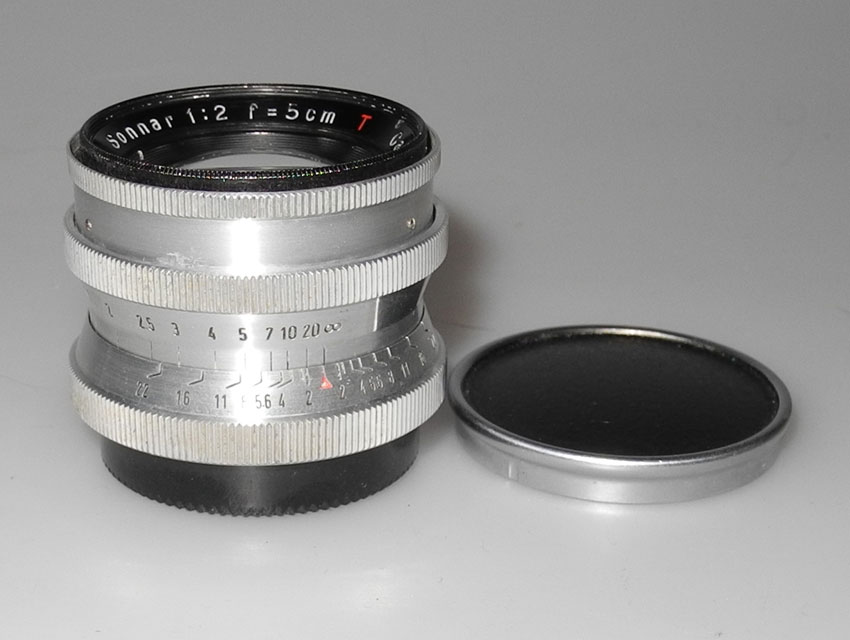
 www.french-camera.com
www.french-camera.com
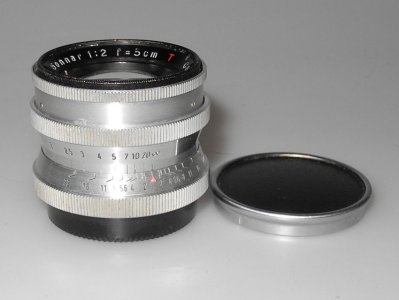
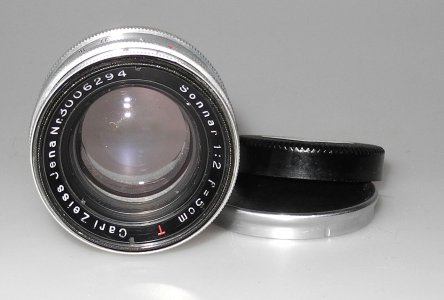
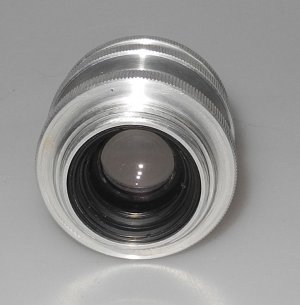

LEICA 5cm/2 SONNAR CHROME CARL ZEISS TRES BEL ETAT
LEICA 5cm/2 SONNAR CHROME CARL ZEISS TRES BEL ETAT, CARL ZEISS OBJECTIF 5cm/2 SONNAR CHROME MONTURE 39 A VIS + BOUCHONS TRES BEL ETAT



TenEleven
Well-known
I have had an f/2 lens (also post-war) and still have an f/1.5 lens of this exact design. I have also seen at least three more copies of the f/1.5 version and one more copy of the f/2 version making yours number three. My assumption is that this is what the post-war official LTM lenses looked like. I have also seen post-war LTM Biogons which strangely enough - retain the original design specification - just like their Contax mount equivalents, which unlike the Contax f/2 and f/1.5 lenses etc. was not changed (much).
Also, the photos don't show it but the mechanism is pretty crude in its execution. A very shallow single helical so the entire lens rotates with a headless screw driven through the focus mount to act as a stopper for the focus range. It works, but is crude and needs thick grease otherwise things get wobbly indeed.
Also, the photos don't show it but the mechanism is pretty crude in its execution. A very shallow single helical so the entire lens rotates with a headless screw driven through the focus mount to act as a stopper for the focus range. It works, but is crude and needs thick grease otherwise things get wobbly indeed.
Räuber
Established
I can confirm everything TenEleven has written. This lens is number 3 of 4 of serials that I collected. It looks like all aluminum and matches the Contax mount version design of East German post-war Sonnar 5cm f/2 lenses. It looks to me that those LTM Sonnars where only build by CZJ during the very first time and in low numbers after WWII.
We can only speculate about this hour glass shaped LTM Sonnars. There are f/1,5 and f/2 LTM Sonnars from the time of WWII and shortly after. Those look different and all have those 2 ears / grippers. When CZJ hit the 3M mark they changed the design of all Sonnar 5cm lenses. There was no need to do this. It would be totally fine to use the old design further. Probably this step was done because of the migration of the Sonnar production to Krasnogorsk. The Soviet administration took all documents, machines, tools and material it could get to the FSU. It seems they allowed some single machines to stay so that CZJ could support the new Soviet production with lenses made in Jena until the Krasnogorsk productions was up and running on full speed. So in Jena there was not much left from the old production facility. And even the stuff that was left was scheduled to be send to Krasnogorsk later. So CZJ started almost from scratch.
Interestingly East Germany housed the majority of the German aluminum production. So there was a wealth of aluminum producing factory in the Soviet sector and aluminum was cheap. A lot of goods of the daily life were made from aluminum in the GDR later. Maybe that was a reason for housing all post-war CZJ Sonnars in light aluminum bodies.
Redesigning the Sonnar lens might have been a necessity for CZJ in other ways too. The new Krasnogorsk production spit out Jupiters that matched the old CZJ design. The proud CZJ might not like the fact that Soviets now produce copies of their lenses. So they might have changed the design to show the world how a real CZJ lens looks like. On the other side they might have wanted to go forward after a terrible war and after rough years with a new fresh design that does not look like the pre-war design at all. And next CZJ was still able to sell Contax lenses to the west. They wanted to show the world that they are still alive and ready to move to a new future. So they needed a design that tells the world "Look, this is a modern lens! Greetings from Jena!".
The new design might look simple but it provides a clean design language. I might argue that it could have been inspired from Bauhaus. But it provides some improvements as well. The aperture ring is bigger than before. The numbers of the aperture scale are bigger too. This all makes it easier to see and adjust the aperture of the new lens.
I think CZJ started production of LTM Sonnars at first because it was speculating to sell this off to the western market more easily. But it seems they where stopped very soon. Maybe the Soviet administration was more interested to sell Krasnogorsk LTM lenses itself. In the end the LTM Sonnar production was very short lived. The Contax Sonnar production only lasted fro 3 years. After which it was stopped in favor for the Soviet Jupiter production.
We can only speculate about this hour glass shaped LTM Sonnars. There are f/1,5 and f/2 LTM Sonnars from the time of WWII and shortly after. Those look different and all have those 2 ears / grippers. When CZJ hit the 3M mark they changed the design of all Sonnar 5cm lenses. There was no need to do this. It would be totally fine to use the old design further. Probably this step was done because of the migration of the Sonnar production to Krasnogorsk. The Soviet administration took all documents, machines, tools and material it could get to the FSU. It seems they allowed some single machines to stay so that CZJ could support the new Soviet production with lenses made in Jena until the Krasnogorsk productions was up and running on full speed. So in Jena there was not much left from the old production facility. And even the stuff that was left was scheduled to be send to Krasnogorsk later. So CZJ started almost from scratch.
Interestingly East Germany housed the majority of the German aluminum production. So there was a wealth of aluminum producing factory in the Soviet sector and aluminum was cheap. A lot of goods of the daily life were made from aluminum in the GDR later. Maybe that was a reason for housing all post-war CZJ Sonnars in light aluminum bodies.
Redesigning the Sonnar lens might have been a necessity for CZJ in other ways too. The new Krasnogorsk production spit out Jupiters that matched the old CZJ design. The proud CZJ might not like the fact that Soviets now produce copies of their lenses. So they might have changed the design to show the world how a real CZJ lens looks like. On the other side they might have wanted to go forward after a terrible war and after rough years with a new fresh design that does not look like the pre-war design at all. And next CZJ was still able to sell Contax lenses to the west. They wanted to show the world that they are still alive and ready to move to a new future. So they needed a design that tells the world "Look, this is a modern lens! Greetings from Jena!".
The new design might look simple but it provides a clean design language. I might argue that it could have been inspired from Bauhaus. But it provides some improvements as well. The aperture ring is bigger than before. The numbers of the aperture scale are bigger too. This all makes it easier to see and adjust the aperture of the new lens.
I think CZJ started production of LTM Sonnars at first because it was speculating to sell this off to the western market more easily. But it seems they where stopped very soon. Maybe the Soviet administration was more interested to sell Krasnogorsk LTM lenses itself. In the end the LTM Sonnar production was very short lived. The Contax Sonnar production only lasted fro 3 years. After which it was stopped in favor for the Soviet Jupiter production.
My belief, after handling this one and a few others- probably a made-on request jobs, done in the machine shop. I do not believe these were ever intended for regular production. No easy way of disassembling the helical, ie not held together using set screws. Too crude of a design.
dexdog
Mentor
Any thoughts on this lens? I bought it a long time ago on eBay before I had a copy of Thiele's book of CZJ lenses. I picked it up because of the unusual serial, i.e., a high number but under 3 million. Thiele's book shows it as part of a batch of 100 lenses, no dates given, has "beleg fehlt" in the notes which google says means "no records available". Looking at the lens just now, I probably need to clean a bit of haze off the interior lens surfaces




Räuber
Established
Any thoughts on this lens? I bought it a long time ago on eBay before I had a copy of Thiele's book of CZJ lenses. I picked it up because of the unusual serial, i.e., a high number but under 3 million. Thiele's book shows it as part of a batch of 100 lenses, no dates given, has "beleg fehlt" in the notes which google says means "no records available". Looking at the lens just now, I probably need to clean a bit of haze off the interior lens surfaces

Have not seen this one before. BUT it seems it is an evolution between the war Sonnar and the post-war Sonnar.
I have seen 2 very similar Sonnars in the past.
Serial 2859528
- aperture ring of later Sonnars (post-war Sonnar)
- red dot aperture mark over grip ring
- barrel shaped body without square lines (looks more like war time Sonnars)
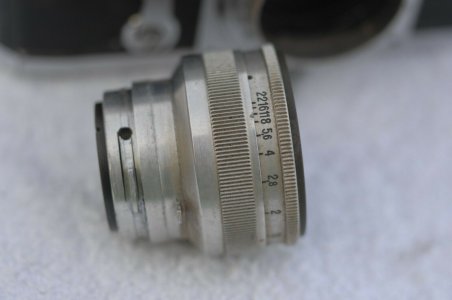
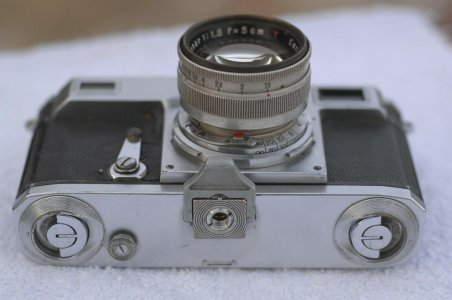
Serial 2986077
- aperture ring of later Sonnars (post-war Sonnar)
- aperture mark not visible
- big grip ring, conical body, conical mount part (like post-war Sonnars)
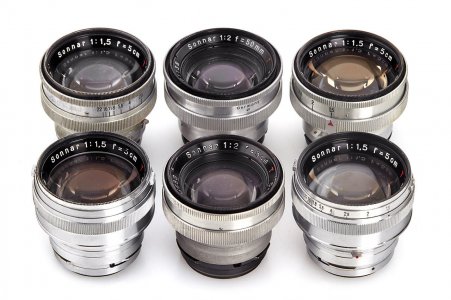
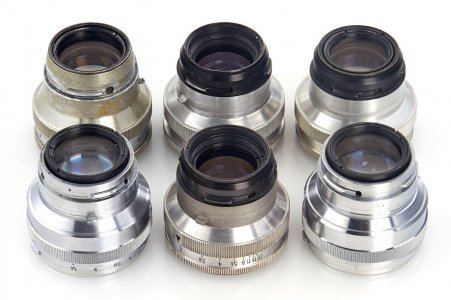
Seems like CZJ refined the design of the post-war Sonnar 5cm f/1,5 T in small steps over time. They painted the mount part with black paint later. And they added a big black arrow (later red) as part of the grip ring. Your lens is one of the last steps before they reached the final design that they kept until they stalled the production in 1948.
When you clean it- post some pictures of the optics. That should relate it to wartime, or post-war. measure the diameters with your calipers as well.Any thoughts on this lens? I bought it a long time ago on eBay before I had a copy of Thiele's book of CZJ lenses. I picked it up because of the unusual serial, i.e., a high number but under 3 million. Thiele's book shows it as part of a batch of 100 lenses, no dates given, has "beleg fehlt" in the notes which google says means "no records available". Looking at the lens just now, I probably need to clean a bit of haze off the interior lens surfaces

Share:
-
This site uses cookies to help personalise content, tailor your experience and to keep you logged in if you register.
By continuing to use this site, you are consenting to our use of cookies.




